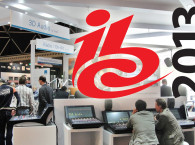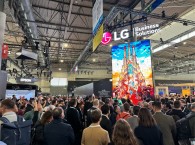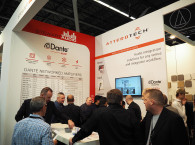Following a few intense days in the extremely warm and dry environment in Berlin, attending IFA 2024 - the Big CE Supermarket as I called it in my 2015 report - it felt great to move on to Amsterdam and attend the vibrant International Broadcasting Convention (IBC). Great, if it wasn't for the sudden change in weather with unexpected rain and a sudden drastic drop in temperature.

What's always interesting about going from one of the largest events for the consumer electronics industry such as IFA, to one of the largest professional media events in the world, is the contrast in the structures for each industry. Consumer events suffer from the fact that both exhibitors and attendees have no clear rules of engagement - Are you a buyer or a seller? Are you a brand or a manufacturer? Are you selling technology, services, or products? Are you a manufacturer, an OEM, ODM, or pure engineering provider? Are you an OEM, or a reseller? Or are you a distributor, or a wholesaler? Are you a regional player, Euro-wide, or global? All these profiles match the typical visitor at a show like IFA, and any of these can be found both simply visiting or exhibiting! And when you are exhibiting, you need to be ready to talk to attendees that come to sell, rather than buy what you have. That's a huge mess - but that's something for the IFA promoters to sort out and establish, obviously.
This confusion is also visible in the names of the trade shows. IFA is no longer the International Funkausstellung, also CES is no longer the Consumer Electronics Show. Organizers value the names and their brands (many decades in the making) so much that they keep renewing their identity. But now they just use the abbreviated form, because the description no longer matches what the show is about.
But I already dedicated nearly 4000 words to my first impressions of IFA 2024... so let's move on.

In contrast, when you move to IBC (which interestingly also only uses the acronym since the "Broadcasting Convention" part no longer fits), things are at least clearer in terms of rules of engagement. Everyone that sells has a booth (or a suite). Everyone that visits is a potential buyer (or press). Companies in the media content production and distribution space are usually much more complex structures than in the consumer space. Everything is much more engineering-minded, and technology choices are defined in terms of standards, trends or emerging industry efforts. I'm being slightly ironic and painting a simple picture. But it's mostly like that.
My job at a show like IBC is also much easier. I go there to see new products and technologies. Because those are launched/unveiled/premiered at trade shows. And the Amsterdam show has a tradition of excellence in that respect. Manufacturers schedule their product announcements for the first day of the show, there is a calendar of press events, and there's a whole ecosystem of PR agencies to support manufacturers in that effort (making our job so much easier).
There's also a different standard that we all wish the consumer industry would endorse. When a manufacturer writes on a press release that the gain is 74dB and the THD+N @-1 dBFS is < -110dB, < 0.00032%, we don't need to measure it to confirm. Those professional specs are a direct statement of the manufacturer's reputation (which will likely be confirmed by its largest clients' engineering and maintenance departments anyway and surpass the scrutiny in procurement processes). Would those not be accurate, the company would likely be out of business. This makes the task of reporting about professional gear much different (not easier), with a need to focus on innovation and usefulness.
Also, in those industry segments, everyone understands what needs to be done to promote a new product. I swear that among the hundreds of press releases from IBC I've seen an announcement of a metal shelf for a 19" rack that arrived in our inbox duly supported with an 800-word press release and two high-resolution photos. Shame on all those hifi companies that launch systems worth thousands of dollars, don't even send out a press release, and three years later are still inviting the press to "discover" their "latest example of craftsmanship."
And I'll close my introductory ramblings with a very simple statement. Independently of how many attendees visit a trade show, in general I noticed that there is a sense of communion that unites everyone, exhibitors, attendees, and working in some function at the event. At IBC 2024 I've felt people happy to be there. And depending on what you do in the industry, you get invited to lots of events and parties.
In contrast, at IFA I've met many people that weren't sure why they were there. And typically asked me things like "don't you think the show is smaller this year?"


OK. How Good Was It?
Within the RAI Amsterdam (September 13-16), I felt a vibrant environment. There was a sense of celebration, excitement, and clear signs of business being done during IBC 2024 - which is always the best sign of a trade show. The show was also back to expansion halls in parking lots to accommodate more exhibitors, even though we are still not at the pre-pandemic levels. But to compensate, attendance was very robust.
To confirm my impressions, IBC reported 45,085 attendees from 170 countries, which is 2,000 more visitors than last year. The show also attracted more than 1,350 exhibitors – up 100 from 2023. This is still less than the 56,390 total attendance at IBC 2019, but at least this year no one was talking about Amazon Alexa or promoting Android TV. At IBC 2024 voice assistants are just an essential component of AI-Everything, and there was just a few Chinese companies that still offer "Android" set-top-boxes for $10. Everything is now fully integrated into the "smart" TVs, which is why Realtek, Mediatek, Broadcom, and others had so many private suites in the galleries above the halls.
To justify the excitement, IBC 2024 addressed critical trends and issues driving the media landscape, such as using AI to combat false information and fake news, while using AI to automate and accelerate challenging tasks, such as metadata indexing, archival classification, or music and audio identification. Of course, the use of AI in areas such as automatic closed captioning is also converging with existing industry trends in transcription and translation tools, which was a big topic this year. And yes, voice interfaces are still there, timidly waiting to make their "AI-powered" comeback.
A new feature at IBC 2024, the AI Tech Zone, was predominantly about AI automation, but other topics seen across the show included the use of 5G for content contribution and broadcast, immersive audio production and distribution (Dolby has everything sorted with Dolby Atmos, MPEG-H is nearly there, and Google now says it also has "spatial" and wants to give it away for free). Otherwise, I will not bother to expand on the typical television market trends, which are all about "everything in the cloud," over-the-top (OTT), and streaming instead of broadcasting (which is strange since sustainability is another big topic, and everyone knows that broadcast is the most sustainable technology of all).


New for this year was the AI Media Production Lab, exploring a series of projects and AI concepts, where one of the hottest Accelerator projects – also addressed during the IBC Conference – was "Design Your Weapons in the Fight Against Disinformation," and how to help audiences identify trustworthy news and information. A very relevant topic everywhere, but particularly serious in the US. Also, a slightly ironic topic during a show attended by many of the media outlets that are direct agents of disinformation... but hey, if you sell cameras, you don't look at faces.
I confess that I have been away from the market intricacies of the television and media distribution market for more than a decade now. When I go to NAB in Las Vegas, NV, I focus on the content creation section, where Hollywood meets YouTube. At IBC, I quickly visit the largest booths from Arri, Avid, Blackmagic, Sony, Grass Valley, Ross Video, Telestream, and many others I still recognize, and struggle to identify what the other large booths are and do. But unlike at NAB, there is one hall that is practically dominated by audio and radio companies, which makes everything easier.
That's where you can meet all the microphone manufacturers, studio monitor, mixing consoles, audio processors, and radio systems companies. And they all have new product launches to show, which audioXpress has been covering here. Those are the fundamental tools that continue to support the needs of media and entertainment content production. And it also helps that IBC always fosters a great combination of creative, technology, and business conversations.

And What Happened There That I Should Know?
There is a lot to talk about in audio for television and radio, but most of what I could discuss is product related, and I would prefer to keep that for dedicated posts on Industry News and Product News on the audioXpress website.
But there was one clear trend that I want to highlight from this year's show.
I have discussed several times that I think there is a clear lack of progress in the development of audio networking technologies serving all the market and application segments, from broadcast to live production and performance, to studio, commercial installation, to residential and smart home. And one of the reasons why I feel that audio networking technologies have been stalling for the past five or six years, is that all the work is happening in the convergence with media distribution networks in combination with video signals. Everything has been focused on transport protocols, and very little on connectivity.
The problem is the audio networking puzzle is not complete until we have standards for connectivity, control and monitoring of networks. Based on industry standards, or proprietary, licensed technologies. For now, those efforts, such as those of the Open Control Architecture (OCA) Alliance and the AES70 standard, have largely stalled (for several reasons that I know well, but I couldn't expand here). There are products being announced, basically to benefit the commercial efforts of specific companies that refuse to embrace audio-over-IP as already implemented in practice in every application segment of audio production. As AES70/OCA continues to focus on the "interoperability" of these fragmented efforts, and system integration for media networking solutions, no standards effort completed the much needed audio networking puzzle.
I could see this at every show I attended for the past years, and I could clearly see this happening at IBC. And while the "open standard" efforts continue to stall and move in circles, there is a company that continues to grow and expand its business, having created a de facto standard. That company has dominated professional audio applications in live performance and production, commercial installation, studio recording, evolved toward residential installation, and is now conquering the last and most difficult of sectors, which is media production and broadcasting.
That company is Audinate, and the technology is Dante.


I have been witnessing how Audinate has gradually transformed its strategy and solutions roadmap to adjust to the requirements and challenges of each industry application. And I have seen consistent progress, which has not always been smooth. After attending the NAB Show in April 2023, I was not expecting to suddenly see Dante so prominent at IBC 2024.
Audinate announced several new resellers for its Dante Connect cloud-based broadcast audio production solutions at IBC 2024. The company has enlisted system integrators, distributors, and pure resellers. In those announcements, I could see experienced companies (many of which have previously embraced other networking technologies), praise the "production flexibility using centralized audio production in the cloud," "consistent workflow support," and the cost-effectiveness of the products and solutions. "Integrating Dante audio into cloud-based broadcast workflows just makes sense,” says CineSys, one of those new resellers and integrators.
I visited the booths of all the mixing console manufacturers (because they are at the core of audio operations) and everywhere I noticed the Dante signs. The Dante Connect software suite is described as "a powerful platform for A1s and mixing engineers, combining the familiarity, ease of use and tight synchronization of Dante audio with seamless connectivity to centralized production tools running on cloud instances." Just one of the several examples of consistency from Audinate in gradually expanding Dante as an all-encompassing solution.
At IBC, I visited Audinate to see how this strategy continues to grow with new features, product integrations, and platform options. The most surprising announcement was the fact that Dante was embraced by Calrec, Lawo, and Telos Alliance. All these manufacturers have previously developed their own audio networking protocols and solutions, later having embraced AES67 to allow interoperability between various IP-based audio networking systems, and its own Hydra2, RAVENNA, and Livewire technologies, respectively. At IBC 2024, all these technologies joined the Dante ecosystem to support native Dante audio transmission.

The (surprising, for many) move is easily explained by the need to move to cloud-based solutions, and Audinate's aggressive strategy to make development tools available to everyone. Audinate recently released the new SDK for Dante Connect that enables software developers to build Dante audio transmission and reception natively into their cloud-based applications. Which means, everyone can join with Dante.
Using the Dante SDK, software developers get free access to send and receive Dante audio to any Dante-enabled hardware and software. Licensing for Dante audio support is managed by Dante Connect, freeing developers to add functionality without additional costs. The end customers are the ones deciding to license Dante Connect if they so wish, enabling native Dante connections and cloud-based Dante Virtual Soundcard integrations.
Not surprisingly, at IBC 2024, Dante-native cloud-based tools have been announced by Solid State Logic and Waves, as well as solutions connected by Dante Virtual Soundcard from Grass Valley, Harrison, Riedel, and Vizrt. According to Audinate, "the ecosystem now includes eleven professional tools that broadcasters can selectively integrate into their workflows."
“Providing Dante integration on a server-based microservice level yields a vast range of creative benefits for operators as it helps them navigate the transition to future-proof hardware-abstracted processing,” says Jamie Dunn, Lawo's Deputy CEO. Lawo even announced the intention to collaborate with Audinate and signed a Memorandum of Understanding for the integration of Dante audio and video technologies.
There's a lot more to this. But I will summarize it like this. It's over. Dante has proven to fulfill all the needs at the largest live events, festivals, and concerts, connect airports, and manage all audio signals in the largest conference centers. Now it will power the new cloud-based media production and distribution infrastructures.
Audinate is aware that they still have a lot ahead of them. They have cracked the audio networking part and are now the de facto standard. The next step is to allow everyone to see Dante as the new plug-and-play connectivity. Kudos to Audinate. aX
This article was originally published in The Audio Voice newsletter, (#485), September 19, 2024.







